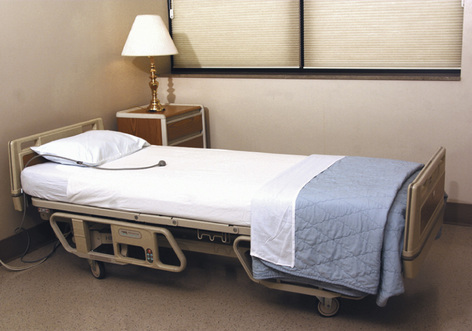Bedmaking
Objectives
• Define the key terms and key abbreviation in this chapter.
• Describe open, closed, occupied, and surgical beds.
• Explain when to change bed linens.
• Explain how to use drawsheets.
• Handle linens following the rules of medical asepsis.
• Perform the procedures described in this chapter.
• Explain how to promote PRIDE in the person, the family, and yourself.
Key Terms
Beds are made every day. Clean, dry, and wrinkle-free beds:
Beds are usually made in the morning after baths. Or they are made while the person is in the shower, up in the chair, or out of the room. To keep beds neat and clean:
• Change linens when they are wet, soiled, or damp.
• Straighten linens whenever loose or wrinkled and at bedtime.
• Check for and remove food and crumbs after meals and snacks.
• Check linens for dentures, eyeglasses, hearing aids, sharp objects, and other items.
Types of Beds
Beds are made in these ways.
• A closed bed is not in use. Top linens are not folded back (Fig. 21-1, p. 320). The bed is ready for a new patient or resident. In nursing centers, closed beds are made for residents who are up during the day.
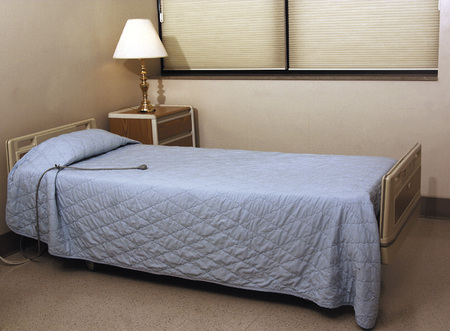
• An open bed is in use. Top linens are fan-folded back so the person can get into bed. A closed bed becomes an open bed by fan-folding back the top linens (Fig. 21-2, p. 320).
• An occupied bed is made with the person in it (Fig. 21-3, p. 320).
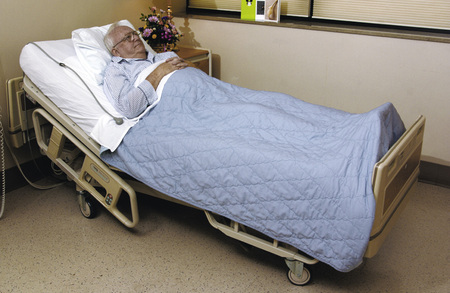
• A surgical bed is made to transfer a person from a stretcher to bed (Fig. 21-4, p. 320). This includes an ambulance stretcher.
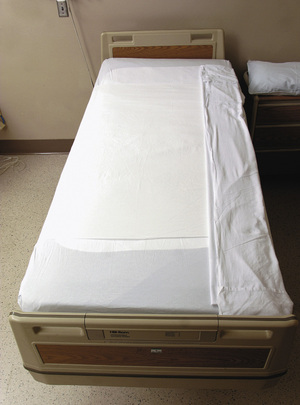
Linens
When handling linens and making beds, practice medical asepsis. Your uniform is considered dirty. Always hold linens away from your body and uniform (Fig. 21-5). Never shake linens. Shaking them spreads microbes. Place clean linens on a clean surface. Never put clean or used linens on the floor.

Collect enough linens. If the person has 2 pillows, get 2 pillowcases. The person may need extra blankets for warmth. Do not bring unneeded linens to a person’s room. Once in the person’s room, extra linens are considered contaminated. Do not use them for another person.
Collect linens in the order you will use them. That way you avoid fumbling with linens to find the piece you need. Linens stay neat and clean in your pile. You will use bed linens in the following order.
• Bottom sheet (flat or fitted)
• Cotton or padded waterproof drawsheet (if needed)
• Waterproof under-pad (if needed)
• Blanket
You may also need:
Use 1 arm to hold the linens. Use your other hand to pick them up. The first item you will use is at the bottom of the stack. To get it on top, place your arm over the stack. Then turn the stack over onto the other arm (Fig. 21-6). The first item you will use is now on top. Place the clean linens on a clean surface.
Remove used linens 1 piece at a time. Roll each piece away from you. The side that touched the person is inside the roll and away from you (Fig. 21-7). Discard each piece into a laundry bag.

In hospitals, top and bottom sheets, the drawsheet, waterproof under-pad (if used), and pillowcases are changed daily. If still clean, the mattress pad, blanket, and bedspread are re-used for the same person. They are not re-used if soiled, wet, or wrinkled. Change wet, damp, or soiled linens right away. Wear gloves and follow Standard Precautions and the Bloodborne Pathogen Standard.
See Focus on Long-Term Care and Home Care: Linens.
Drawsheets
A drawsheet is a small sheet placed over the middle of the bottom sheet. The drawsheet may have tuck tails for tucking the sheet under the mattress.
• A cotton drawsheet is made of cotton. It helps keep the mattress and bottom linens clean (Fig. 21-8, A).

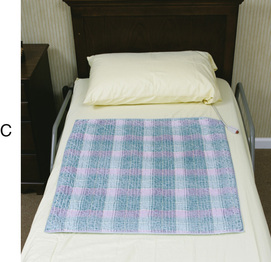
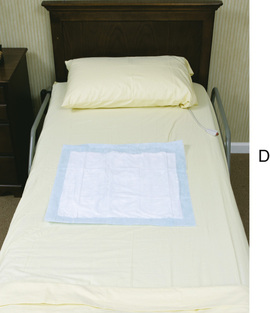
• A padded waterproof drawsheet is a drawsheet made of an absorbent top and waterproof bottom (Fig. 21-8, B). It protects the mattress and bottom linens from dampness and soiling. The waterproof side is placed down, away from the person. The absorbent top is placed up, toward the person. Other waterproof drawsheets are disposable. They are discarded when wet, soiled, or wrinkled.
Many agencies use incontinence products (Chapter 24) to keep the person and linens dry. Waterproof under-pads or disposable bed protectors also are common (Fig. 21-8, C and D).
Plastic-covered mattresses cause some persons to perspire heavily, causing discomfort. A drawsheet reduces heat retention and absorbs moisture. Drawsheets are often used as assist devices to move and transfer persons in bed (Chapters 18 and 19). If used as an assist device, do not tuck the drawsheet in at the sides.
See Focus on Long-Term Care and Home Care: Drawsheets.
Making Beds
Safety and medical asepsis are important for bedmaking. Follow the rules in Box 21-1.
See Focus on Long-Term Care and Home Care: Making Beds.
See Delegation Guidelines: Making Beds.
See Promoting Safety and Comfort: Making Beds, p. 324.
See Teamwork and Time Management: Making Beds, p. 324.
 The Closed Bed
The Closed Bed
Closed beds are made for:
• New patients and residents. The bed is made after the bed system (Chapter 20) is cleaned and disinfected. Clean linens are needed for the entire bed.
See procedure: Making a Closed Bed.

